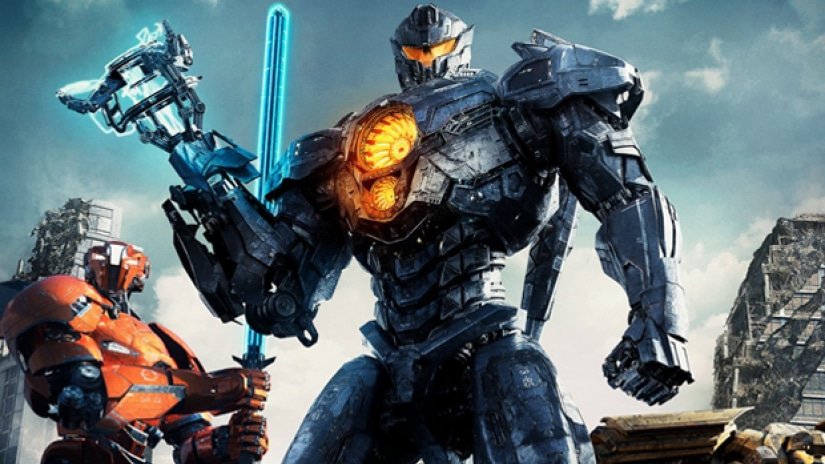
These films offer a number of narrative nuggets that make for a rich interconnected universe.
The sequel to Guillermo del Toro’s Pacific Rim, Pacific Rim: Uprising, just hit theaters this week. For fans of the original, it feels a little bit like a ‘pinch yourself’ moment in that Uprising is an actual film that exists after five years of development hiccups.
Anyone going into Uprising and expecting a del Toro copy or redo would likely be disappointed, although that wouldn’t have been the wisest watching strategy regardless since Uprising already looked so different from its very first trailer. The reviews have, so far, been predictably mixed given these changes — which include elements such as pacing, tone, design and character development. For some, they aren’t differences that viewers should necessarily disparage since they enliven the film and make for a thoroughly entertaining experience. To other reviews, they could take away from the fun robot-kaiju fighting and add too much “engineering.”
But more importantly, now with two films under its belt, where exactly does the Pacific Rim series go from here? Prepare yourself for some spoilers as we try and unpack this.
The Hollywood Reporter recently posited the argument that Pacific Rim‘s franchise potential really lies in its non-cinematic entities as opposed to the films themselves. So far, the series has spawned the comic anthology, Pacific Rim: Tales From Year Zero, which serves as a prequel to the first Pacific Rim film. Uprising is similarly accompanied by comic precursors that fill in the blank of the ten years that pass between the first movie and the sequel. Pacific Rim: Aftermath and Pacific Rim: Amara each discuss certain themes that are touched on in Uprising: experimentations with Kaiju DNA and the rise of amateur jaegers respectively. But according to THR, “On the evidence of the movies alone, Pacific Rim is a franchise curiously disinterested in its own potential.”
It’s a curious sentiment to purport because the Pacific Rim films do indulge in themes that go beyond the “Giant Robots vs. Monsters” angle within their own stories. The first Pacific Rim works specifically because it’s interested in grounding the film in the lore behind Drift compatibility, focusing on the humans behind the machines (Tales from Year Zero even expands on protagonist Raleigh Becket’s life before leaving the Pan-Pacific Defence Corps). Drift compatibility isn’t just about driving a Jaeger into battle. The principle behind the practice involves understanding your co-pilot intimately, developing trust and a bond to fight to survive; as Raleigh says in the prologue, “The deeper the bond, the better you fight.”
Any victory at the end of Pacific Rim is thus two-fold. Closing the Breach that the Kaiju travel through to earth obviously saves the day, but the film also highlights that inner monsters exist, and you either overcome them and work together to live to see another day, or you let them consume you (as Uprising demonstrates).
Uprising takes the concept of Drifting to a different level by expanding on the first film’s tease about interspecies mind-melding. Newt (Charlie Day) is shown to have been regularly Drifting with a Precursor Kaiju brain in the sequel, causing him to effectively lose control of his body and mind. A monster literally overtakes his faculties, resulting in the construction of hybrid Kaiju-Jaeger drones. The lore of Jaeger tech (which was of course established in the first film) is expanded upon by combining a Kaiju brain with a Jaeger piloting system in some kind of Dalek-like marriage of a drone. On the side of amateur Jaeger building, the film touches on that too, although perhaps in less detail.
Uprising also doesn’t completely neglect the Drift lore from the first film, although, with so many new characters, the process is breezed past considerably. The film dedicates a chunk of time towards fleshing out the bonds between all the new characters in order to create feasible Drift possibilities between the new core team Jake (John Boyega), Nate (Scott Eastwood), and Amara (Cailee Spaeny). There are a ton of shiny new Jaegers commissioned at Shatterdomes worldwide, but without their pilots, they’re pretty much just hunks of metal.
The Kaiju are still a mystery — they can combine themselves into one Super-Kaiju? What?! — but that’s what the potential third movie is for. Uprising teases that Jake and other Jaeger pilots are about to take the fight to the Precursors themselves, immediately opening up the possibility for another sequel to round the series off. This, in itself, opens up more franchising options to be explored in another film.
THR isn’t wrong to say that extra materials like the Pacific Rim comics add so much more to the lore than we’re able to see in the films themselves. But the supplementary material isn’t something uncommon in any franchise — Pacific Rim just covers its bases by releasing these works simultaneously for anyone who’s interested. The films themselves provide a wealth of possibilities that showcase they’re interested in evolving their ideas alongside the glossy action sequences.
Related Topics: Pacific Rim, Pacific Rim Uprising

